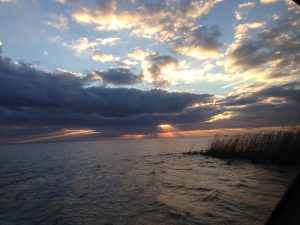Project Synergies: Getting the Most Bang for our Buck from Coastal Restoration
Coastal restoration is not cheap. Most projects cost on the order of millions, sometimes billions, to plan, design and construct. Such high stakes call for solutions that provide the greatest benefit over the long term. But how do you select projects that provide the most bang for the buck? Part of the answer lies in project synergies and complementary projects.
What are synergies?
Synergies are the interactions between projects that happen based on project scale, location and timing of construction or operations. These relationships produce additional benefits that would not arise if the projects existed independently of one another.
Diversions and marsh creation
The most popular example of project synergies is that of sediment diversion and marsh creation projects. Diversions reconnect the river to its delta, which enables land-building to continue over time. Marsh creation projects, on the other hand, can build hundreds of acres of land in a few years by supplying large amounts of sediment to a selected site.
Sediment diversions direct fresh water loaded with sediment from the main river channel into surrounding wetlands. The inflow of sediment, fresh water and nutrients provides substrate and food that will encourage vegetation growth and limit saltwater intrusion. There is concern, however, that diversions will not produce substantial results for ten or more years after construction. That’s where marsh creation comes in.
Marsh creation projects grant immediate relief to subsiding environments, but they are vulnerable to erosion. When paired together, marsh creation provides structure for sediment from diversions to settle out onto and accrete. Diversions can also offset the natural erosion and subsidence of marshes by continuing to supply sediment over time.
The synergy between sediment diversions and marsh creation will accelerate land-building and increase marsh resiliency.
Mid-Barataria Sediment Diversion and Large-Scale Barataria Marsh Creation
The Mid-Barataria Sediment Diversion is slated for construction along the Mississippi River at Rivermile 61, south of New Orleans. This sediment diversion will reconnect the Barataria Basin to the main river channel. Operating the diversion at the planned 75,000 cfs will maximize the sediment load conveyed to the basin.

The sediment conveyance channel for the Mid-Barataria Sediment Diversion is set to be constructed within the red outline. The sediment will empty into the Barataria Basin, shown as the dark-colored marshlands in the bottom left-hand corner of the image. Credit: CPRA
Large-Scale Barataria Marsh Creation lies within the diversion’s outfall area. The marsh creation project alone will create 12,400 acres of constructed marsh, and implementation and operation of the Mid-Barataria Sediment Diversion will increase that number.

Aerial view of Bayou Dupont Marsh and Ridge Creation project, a component of the Large-Scale Barataria Marsh Creation. Credit: Patrick M. Quigley
Although construction of several components of the Large-Scale Barataria Marsh Creation project have been completed and others are underway, the Mid-Barataria Sediment Diversion is not projected to begin construction until 2022. Restore the Mississippi River Delta is vigorously advocating for an accelerated timeline to get this important restoration project to construction sooner. Directing the diversion into the marsh will build and sustain more land and will do so via natural deltaic processes. When it comes to restoration, thinking synergies is thinking smart.
Your Voice is Needed on a Critical Restoration Project for Louisiana’s Coast |
|
 |
As the State of Louisiana and the U.S. Army Corps of Engineers (Corps) move forward with the permitting process for the Mid-Barataria Sediment Diversion – one of the most important restoration projects in the Coastal Master Plan – your voice and support are needed. |
Andrus, T. M. (2007). Sediment flux and fate in the Mississippi River Diversion at West Bay: observation study. Louisiana State University. https://doi.org/10.1061/40926(239)55
Attachment A8: Project Fact Sheets. (2017). In Louisiana’s Comprehensive Master Plan for a Sustainable Coast (pp. 1–294). Baton Rouge, Louisiana: Coastal Protection and Restoration Authority of Louisiana. Retrieved from http://coastal.la.gov/wp-content/uploads/2017/04/Attachment-A8_FINAL_05.17.2017.pdf
Barras, J. A., Padgett, W. C., & Sanders, C. B. (2009). Aerial and Bathymetric Spatial Change Analysis of the West Bay Sediment Diversion Receiving Area, Louisiana for U.S. Army Engineer District, New Orleans (MVN) Report (p. 39). Mobile District Spatial Data & US Army Corps of Engineers. Retrieved from https://drive.google.com/open?id=0BzU8KzWRzDvUUUltTHNTdFBEX00
Day, J., G.P. Kemp, A. Freeman, and D. Muth (Eds.). (2014). The Once and Future Delta. Dordrecht, The Netherlands: Springer. 490 pp.
DeLaune, R. D., Kongchum, M., White, J. R., and A. Jugsujinda. (2013). Freshwater diversions as an ecosystem management tool for maintaining soil organic matter accretion in coastal marshes. CATENA, 107, 139–144. https://doi.org/10.1016/j.catena.2013.02.012
Khalil, S. M., Raynie, R. C., Muhammad, Z., & Killebrew, C. (2011). Overview of coastal restoration in Louisiana. Shore & Beach, 79(3). Retrieved from https://drive.google.com/open?id=0BzU8KzWRzDvUcDlsMFktWkJlNXc
Reed, D. J. (2004). Concepts for Large Scale Restoration in Coastal Louisiana Using Long Distance Conveyance of Dredged Material. University of New Orleans. Retrieved from https://drive.google.com/open?id=0BzU8KzWRzDvUdmwwYkFESG5KaVE
Roberts, H. H., DeLaune, R. D., White, J. R., Li, C., Sasser, C. E., Braud, D., … Khalil, S. (2015). Floods and Cold Front Passages: Impacts on Coastal Marshes in a River Diversion Setting (Wax Lake Delta Area, Louisiana). Journal of Coastal Research, 1057–1068. https://doi.org/10.2112/JCOASTRES-D-14-00173.1